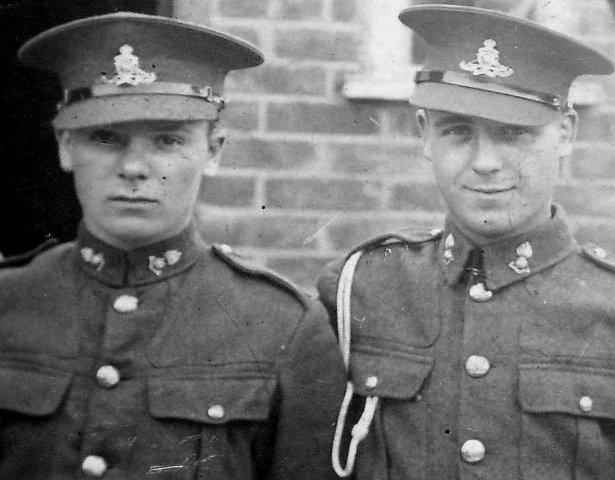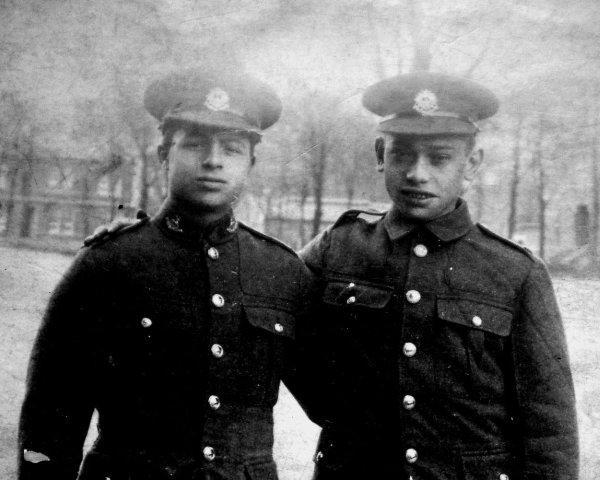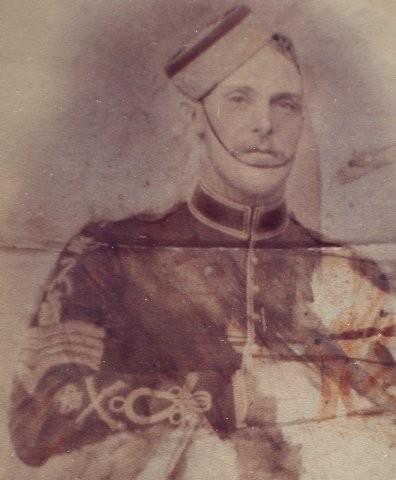
Jeanette
-
Posts
46 -
Joined
-
Last visited
Content Type
Profiles
Forums
Blogs
Gallery
Events
Store
Posts posted by Jeanette
-
-
Hi Liegh,I think the collar dogs are the key(I don'y have any information on them)But the badge is just blurry enough to get confused as it does appear to have a crown at the top thats why I went that route.
The 1st Batt. served in India prior to the war so it could be a fit.
John
Hi, My Dad says that his Dad certainly did serve in India prior to the second world war war, he later on ended up in Dunkirk in The Royal Artillery [can they swap regiments?]like my Dad said?. He was taken off the beaches at Dunkirk, shot in the foot, shrapnel, after that he was sent to Aldershot to train fresh recruits for the rest of the war, they would never let him go back, which probably saved his life!.Thank ypu so much for your input, very helpful, written everything down!!.
Kind regards J. Newton..
0 -
Sorry chaps, the cap badges are The Bedfordshire & Hertforshire Regiment (The Beds & Herts or "Beds & Hearts").
The regiment went through WWI as the Bedfordshire Regiment, but at the end of the war the were renamed to reflect the fact that it had included a large number of men from Hertfordshire.
There was a Hertfordshire Regiment, which continued in existence, but it was'nt a "regular" regiment, it was one of the four Territorial Force infantry regiments (the others being the Cambridgeshire, Monmouthshire & Herefordshire Regiments) that existed, although they were in effect TF battalions of regular regiments.
The photo is 1920's at a guess? - they're wearing Beds & Herts cap badges & regimental buttons rather than the WWI era General Service pattern, one wearing the collar badges, which tended not to be worn during WWI, & the lad on the right is wearing what looks like a curved shoulder title, but unlike the simple one word curved title of the regulars this one appears to have a device above it, probably the numeral for a TF battalion?
Anyway, they're wearing the "smartened up" post WWI, or at least the lad on the left is - look at the reworked collar, for a smarter look.
This fellow is wearing a tunic which appears to have "baling creases" in it - look at his left arm, it's possible that he's not been tool careful with the iron or the coat hanger, but it looks as if the tunic has been folded, typical sort of creases in a gartment which has folded & baled in a stack of others.
Hi, this is all totally amazing, I have written everything down, my Dad is amazed, we never even noticed the creases in the tunic, but now you mention it, wow!!, has given us alot to go on, everybody's inpur has been great,
Kind regards J. Newton.
0 -
1st Batt mainly at home.
2nd Batt. India 1922-33
Sudan 1934
Home 1935
France 1939-40
John
thank you kindly, J. Newton
0 -
Where would they have been stationed, in the late 1920s--at home, or abroad?
We think abroad, my dad says.
0 -
1st Batt mainly at home.
2nd Batt. India 1922-33
Sudan 1934
Home 1935
France 1939-40
John
Thank you so much, I can look these up, many thanks,
Kind regards J. Newton/
0 -
Where would they have been stationed, in the late 1920s--at home, or abroad?
Probably abroad my Dad says.
Kind regards, J. Newton
0 -
Jeanette,
Looks like the Notts & Derby (Sherwood Foresters) Regt.
John
Thank you so much,
regards J. Newton.
0 -
Royal Artillery
John
Thank you so much
0 -
Royal Artillery
John
Thank you so much, that is a great help.
Kin regards J. Newton.
0 -

These men were friends of William John Beadle, would be interested in their regiment too, I can then label the photo's. My son Sam is really into War History, and it is so fascinating, once again, any input would be gratefully received.
Kind regards Mrs. Jeanette Newton.
0 -

The guy on the left as you look on this picture is William John Beadle, we think was taken in India?, as far as my Dad can remember, but he and I would love to know what regiment?, can anyone steer in the right direction.He [William John Beadle] actually was at Dunkirk when they were rescued from the beaches, my Dad said he never talked about it, this picture was taken early on in his career, he was, we believe, a drill sargeant later on.Any information is gratefully received,
Kind Regards Jeanette Newton.
0 -
Thank you so much for the trouble you took to reply, I am thrilled, this is the most we have ever known about James Carter.The badge between the the spur and chevrons, my son thought it was a winged horse, but am wondering whether Dragon might be correct, I will look up Portcullis as not sure what that looks like. Do you think these are the more likely Badges for him?, I would love to know if he actually fought or was just an instructor, as I know nothing of the life he may of lead. I understand it is hard to look up service records in this field. It is a shame the picture isn't more clear, we always tried to make out the Badge between the spur and chevrons, we wondered if there were many for that era?,hoping to narrow it down!!.
My Grandad told me, his Dad loved horses, unfortunately James Carter died in about 1916 when my Grandad was about 8 years old., he was a Stevedore then, he fell into a dry dock, so sad, but that is all we know,his poor wife had about 10 children to bring up on her own!.She , Alice Maria took to cobbling just to survive. We only know that in 1901 he was living in West Ham, so we gather he must have left the army before that time, what time frame we have no idea. But, thank you so much, I know my Mum and Dad will be thrilled when I show them your reply this morning, my Mum is James Carter's grandaughter, shame she never got to know him.
All input is greatly received, every person has a story to be told,when I look at him, I can only wonder, but gratefully you have given me some idea. Once again thank you, Kind regards Mrs. Jeanette Newton.
0 -
Hi, I am new to all this, I have posted a photo of my Great Grandad, born 1861, we believe that he was a Rough Rider,and may have been based at Woolwich, it says you are looking for photo's of soldiers, just thought you may be interested just to take a look,
Kind Regards Jeanette Newton.
0 -
I'm looking for some information about the 4th Battalion, Duke of Cambridge's Own (Middlesex Regiment) before the war. I'm also trying to figure out more about the British Army system, since it differs quite a lot from ours in Finland
 As I understand, they were at first stationed at Woolwich (where it was first raised in Feb, 1900), moving in 1901 to Aldershot. It was never outside the British Isles till it landed at Boulogne on August 14, 1914.
As I understand, they were at first stationed at Woolwich (where it was first raised in Feb, 1900), moving in 1901 to Aldershot. It was never outside the British Isles till it landed at Boulogne on August 14, 1914. They were in Devonport in August 1914. Any information or accounts about the mobilisation day?
They were entrained for Southampton on 13 August, and embarked on the same day for France via SS Mombasa.
- What I wish to know what part did Mill Hill and Devonport played for this battalion?
- Exactly what is ment with term "Depot"? Some sort of assemly place or the headquarters?
- Where did they train?
- Possible biographies of the soldiers who served there before 1914 would also be welcome. Also period photographs.
Regards,
Tuomas
PS. This is for a graphic novel I'm working on.
0 -

Born in the U.K, in about 1861, Iden, Sussex,we cannot find anything on our Great Grandad, picture quality doesn't help I know, but I am new to this site, just learning, Kind regards Jeanette Newton.
0


Photo of Great Grandad James Carter born 1861
in Great Britain: Research, Documentation & History
Posted
thank you so much for your input on this, everything helps!!! Did they have Hussars in England?,I not very knowledgeable on the subject.
Kind regards Mrs. J. Newton.